Electroacoustic Comparison and Optimization of Low-Power Impulse Sound-Source Needle Series Electrodes
Abstract
1. Introduction
2. Methods
2.1. Principle
2.2. Experiment and Verification
3. Results
3.1. Models
3.2. Different Charging Voltages
3.3. Different Electrode Gaps
3.4. Different Liquid Conductivities
4. Discussion
4.1. Optimization
4.2. Prospects
- Optimized design of electrode configurations: This study focuses only on three typical structures in the needle series, while stick electrodes, coaxial electrodes, and spiral electrodes may be further optimized for impulse wave spectral characteristics through parameter tuning.
- Downhole systems need to withstand the ”three high” of composite working conditions and extreme environment adaptability verification: Downhole operation systems need to withstand the ”three-high” composite working conditions, that is, facing a high temperature of not less than 150 °C, a high pressure of not less than 100 MPa, and a vibration acceleration of not less than 8 g in the harsh working conditions; thus, it is necessary to build an accelerated-aging experimental platform to evaluate the pulse energy storage capacitor’s discharge frequency, aging speed of the electrode materials, and dynamic sealing of the insulation structure for its entire lifecycle reliability.
- Miniaturization and integration: The narrow space on the inner wall of the drill collar puts higher demands on the size requirements and positional arrangement of the various components of the impulse sound source.
- Adaptivity: For varying detection requirements, such as different detection targets, different detection distances, and different excitation conditions, the low-power impulse sound source can be controlled with real-time feedback to adaptively adjust the charging voltage and electrode gap.
- Decoupling under strong noise interference signals: Downhole signals face the challenge of decoupling signals from complex working conditions, high overlap between noise and useful signals from drill bit–rock interactions, multimodal vibration harmonics of the drilling column, and the challenge of separating the useful signals under strong direct wave interference, which is a complex challenge for future engineering realizations.
- Integration with MWD or LWD: Integration greatly promotes the development of geosteering technology, drilling engineering, and reservoir evaluation, and makes “drilling and testing integration” and “real-time reservoir description” possible, which is the key technical direction to improve the success rate and economic efficiency of exploration and development.
5. Conclusions
- (1)
- Reducing the power of an impulsive source system can be synergized by a variety of parameter adjustments. One of the effective ways to accomplish this is to reduce the voltage at which the impulse capacitor is charged. It is worth noting, however, that the reduction in power can lead to a degradation of the acoustic properties of the electrodes.
- (2)
- The needle–plate electrode has the best overall performance among the needle family electrodes, with short pre-breakdown time, high maximum impulse wave intensity, high maximum sound pressure level, and high electroacoustic conversion efficiency under the same conditions. In particular, its optimized low-power version requires only 6.66 kW to maintain a high level of SPL output in the 1 kHz frequency range. This feature significantly enhances its application value in the exploration and development of deep oil and gas reservoirs with drilling.
Author Contributions
Funding
Data Availability Statement
Conflicts of Interest
References
- Ji, Y.; Wang, H. Sensitivity analysis of S waves and their velocity measurement in slow formations from monopole acoustic logging while drilling. Geophysics 2024, 89, D193–D203. [Google Scholar] [CrossRef]
- Li, T.; Wang, Z.; Gu, Y.J.; Wang, R.; Wang, Y. Experimental study of fracture structure effects on acoustic logging data using a synthetic borehole model. J. Pet. Sci. Eng. 2019, 183, 106433. [Google Scholar] [CrossRef]
- Yuan, S.; Wang, Q. New progress and prospect of oilfields development technologies in China. Pet. Explor. Dev. 2018, 45, 657–668. [Google Scholar] [CrossRef]
- Daramola, G.O.; Jacks, B.S.; Ajala, O.A.; Akinoso, A.E. Enhancing oil and gas exploration efficiency through ai-driven seismic imaging and data analysis. Eng. Sci. Technol. J. 2024, 5, 1473–1486. [Google Scholar] [CrossRef]
- Lixin, Q.I. Full wave seismic exploration technology. Pet. Explor. Dev. 2022, 49, 586–595. [Google Scholar]
- Zhang, G.; Li, N.; Guo, H.W. Fracture identification based on remote detection acoustic reflection logging. Appl. Geophys. 2015, 12, 473–481. [Google Scholar] [CrossRef]
- Wei, Z.; Tang, X.; Cao, J. Acoustic radiation and reflection of a logging-while-drilling dipole source. Geophys. J. Int. 2019, 219, 108–128. [Google Scholar] [CrossRef]
- Pan, Y.; He, X.; Chen, H.; Wang, X. Reflection signals and wellbore scattering waves in acoustic logging while drilling. J. Geophys. Eng. 2020, 17, 552–561. [Google Scholar] [CrossRef]
- Wang, S.; Wang, G.; Zeng, L.; Liu, P.; Huang, Y.; Li, S.; Wang, Z.; Zhou, Y. New method for logging identification of natural fractures in shale reservoirs: The Fengcheng formation of the Mahu Sag, China. Mar. Pet. Geol. 2025, 176, 107346. [Google Scholar] [CrossRef]
- Wang, J.; Che, X.; Qiao, W.; Tao, S.; Zhao, Q. Influence of the Transducer-Mounting Method on the Radiation Performance of Acoustic Sources Used in Monopole Acoustic Logging While Drilling. Sensors 2025, 25, 201. [Google Scholar] [CrossRef]
- Fu, X.; Gou, Y.; Li, J. Broadband impedance matching design method for dipole acoustic logging transducer based on sparrow search algorithm. Sens. Actuators A Phys. 2025, 382, 116143. [Google Scholar] [CrossRef]
- Hirabayashi, N. Beamform processing for sonic imaging using monopole and dipole sources. Geophysics 2021, 86, D1–D14. [Google Scholar] [CrossRef]
- Yang, S.; Qiao, W.; Che, X. Numerical simulation of acoustic field in logging-while-drilling borehole generated by linear phased array acoustic transmitter. Geophys. J. Int. 2019, 217, 1080–1088. [Google Scholar] [CrossRef]
- Bi, C.X.; Li, Y.C.; Zhang, Y.B.; Xu, L. Super-resolution imaging of low-frequency sound sources using a corrected monopole time reversal method. J. Sound Vib. 2017, 410, 303–317. [Google Scholar] [CrossRef]
- Wang, J.; Nie, C.; Guan, W.; Zhang, C. Experimental measurements of monopole inner/outer collar waves and estimation of P wave velocity in acoustic LWD. J. Pet. Sci. Eng. 2022, 214, 110539. [Google Scholar] [CrossRef]
- Zhao, Q.; Che, X.; Qiao, W.; Tao, S.; Wang, J. Inversion of radial formation velocity distribution based on monopole acoustic logging while drilling. Geoenergy Sci. Eng. 2023, 231, 212313. [Google Scholar] [CrossRef]
- Tang, X.M.; Patterson, D.J. Single-well S-wave imaging using multicomponent dipole acoustic-log data. Geophysics 2009, 74, WCA211–WCA223. [Google Scholar] [CrossRef]
- Qi, Q.; Cheng, A.C.H.; Li, Y.E. Determination of formation shear attenuation from dipole sonic log data. Geophysics 2019, 84, D73–D79. [Google Scholar] [CrossRef]
- Zhao, Q.; Che, X.; Zuo, C.; Qiao, W. Measurement resolution of acoustic reflection imaging logging with a cylindrical phased array acoustic receiver station. J. Pet. Sci. Eng. 2022, 219, 111073. [Google Scholar] [CrossRef]
- Yang, S.; Qiao, W.; Che, X. Numerical simulation of acoustic fields in formation generated by linear phased array acoustic transmitters during logging while drilling. J. Pet. Sci. Eng. 2019, 182, 106184. [Google Scholar] [CrossRef]
- Tao, S.; Che, X.; Qiao, W.; Wang, J.; Zhao, Q. Numerical simulation of acoustic fields in open boreholes generated by linear phased array acoustic transmitters driven by pulse compression signals. Geophys. Prospect. 2024, 72, 2542–2556. [Google Scholar] [CrossRef]
- Cao, Z.; Zhang, D.; Sun, D.; Yong, J. A method for testing phased array acoustic Doppler velocity log on land. Appl. Acoust. 2016, 103, 102–109. [Google Scholar] [CrossRef]
- Su, X.; Feng, M.; Rogers, S.; Holsen, T.M.; Thagard, S.M. The role of high voltage electrode material in the inactivation of E. coli by direct-in-liquid electrical discharge plasma. Plasma Chem. Plasma Process. 2019, 39, 577–596. [Google Scholar] [CrossRef]
- Gao, X.; Zhou, J.; Du, X. Simulation and Optimization of Transmitting Transducers for Well Logging. Sensors 2024, 24, 6795. [Google Scholar] [CrossRef]
- Yao, X.L.; Zeng, Z.; Chen, J. Investigation of WCu Electrode Erosion Morphology Under Impulse Arcs. High Voltage Engineering. 2006, 32, 21–24. [Google Scholar]
- Du, X.; Zhou, J.; Gao, X. Electroacoustic Analysis and Optimization of Needle-Rod Electrodes for Low-Power Impulse Sound Source. Sensors 2025, 25, 2331. [Google Scholar] [CrossRef] [PubMed]
- Sun, B.; Chang, Y.; Liu, X.; Han, D.; Hu, P.; Ai, L.; Yi, M.; Lu, C.; Xia, G. Radial ablation uniformity of cathode and design of double anode micro-cathode arc thruster. Acta Astronaut. 2024, 221, 108–120. [Google Scholar] [CrossRef]
- Gao, X.; Zhou, J.; Xie, H.; Du, X. Discharge Experiment and Structure Optimisation Simulation of Impulse Sound Source. Energies 2024, 17, 4565. [Google Scholar] [CrossRef]
- Kolb, J.F.; Joshi, R.P.; Xiao, S.; Schoenbach, K.H. Streamers in water and other dielectric liquids. J. Phys. D Appl. Phys. 2008, 41, 234007. [Google Scholar] [CrossRef]
- Zhang, D.; Yang, H.; Su, Z.; Liang, H. Hypersonic shock–shock interaction over double wedge controlled by a supermultichannel high-energy pulsed arc discharge array. Phys. Fluids 2024, 36, 095176. [Google Scholar] [CrossRef]
- Tian, J.; Xiong, Y.; Liu, Z.; Wang, L.; Wang, Y.; Yin, W.; Cheng, Y.; Zhao, Q. Experimental study on the discharge characteristics of high-voltage nanosecond pulsed discharges and its effect on the ignition and combustion processes. Appl. Energy 2024, 374, 124011. [Google Scholar] [CrossRef]
- Sun, L.; Zhang, Y.; Zu, Y.; Guo, J.; Yin, H.; Song, Q.; Tang, X. A solid-state pulse power sub-nanosecond SiC DSRD-based generator with high-voltage and high repetition frequency for pulse discharge water treatment. Environ. Res. 2024, 252, 119053. [Google Scholar] [CrossRef] [PubMed]
- Yu, Y.; Kang, Z. Oscillation suppression for pulsed arc electrohydraulic discharges based on plasma impedance model. J. Electrost. 2024, 129, 103923. [Google Scholar] [CrossRef]
- Tai, T.C.; Bao, S.Y.A.; Boyanapalli, B.K.; Kuo, C.C.; Chang, C.K. Partial Discharge Inception and Breakdown Voltage Analysis in PCB-Based Electrode Structures. Appl. Sci. 2025, 15, 2115. [Google Scholar] [CrossRef]
- Cook, J.A.; Gleeson, A.M.; Roberts, R.M.; Randy, M.R.; Robert, L.R. Spark-generated Bubble Model with Semi-empirical Mass Transport. J. Acoust. Soc. Am. 1997, 101, 1908–1920. [Google Scholar] [CrossRef]
- Roberts, R.M.; Cook, J.A.; Rogers, R.L. The Energy Partition of Underwater Sparks. J. Acoust. Soc. Am. 1996, 99, 3465–3475. [Google Scholar] [CrossRef]
- Eubank, P.T.; Patel, M.R.; Burrufet, M.A. Theoretical Models of the Electrical Discharge Machining Process. III. The Variable Mass, Cylindrical Plasma Model. J. Appl. Phys. 1993, 73, 7900. [Google Scholar] [CrossRef]
- Zhu Zhihao Lan sheng Feng Zhiyuan Lu, K. Numerical Simulation of Pulsed Discharge Plasma in Water Based on COMSOL. Chin. J. Vac. Sci. Technol. 2022, 42, 304–310. [Google Scholar]
- Tong, D.; Zhu, X.; Zou, X. Numerical Simulation of the Preheating Process of Pulse Discharge in Water. High Volt. Eng. 2019, 45, 1461–1467. [Google Scholar]

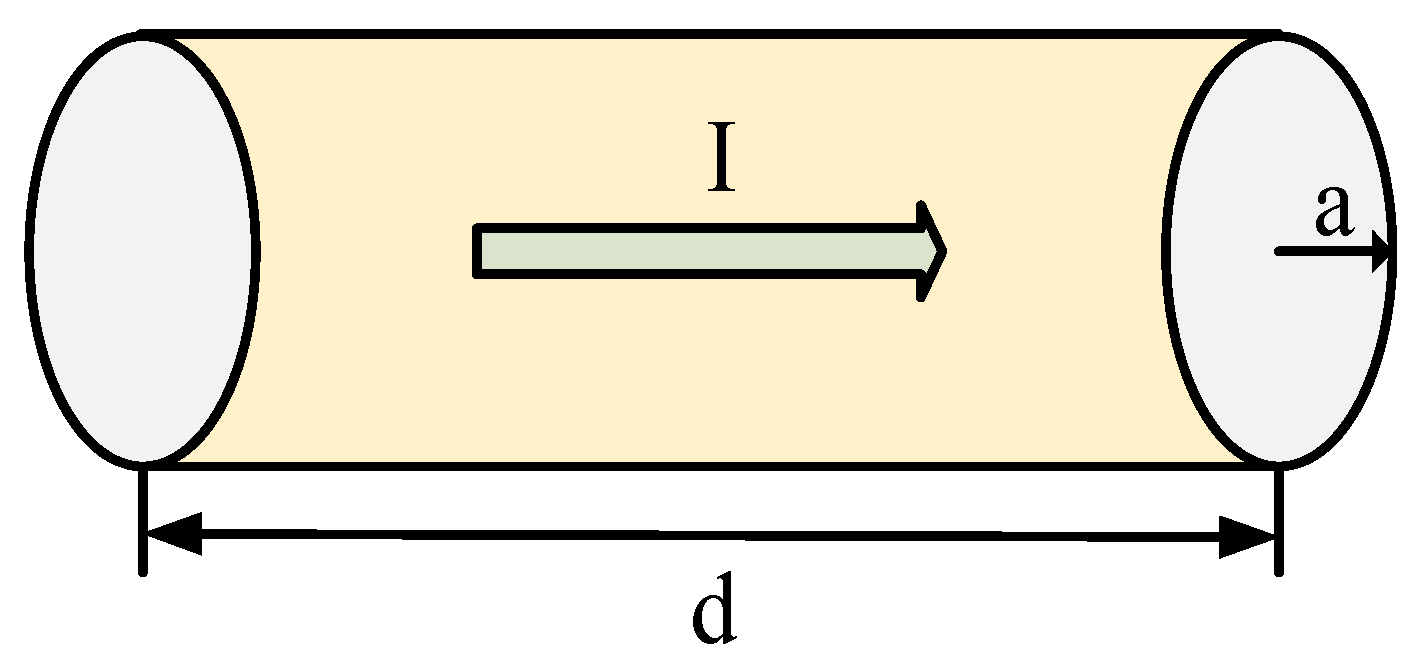
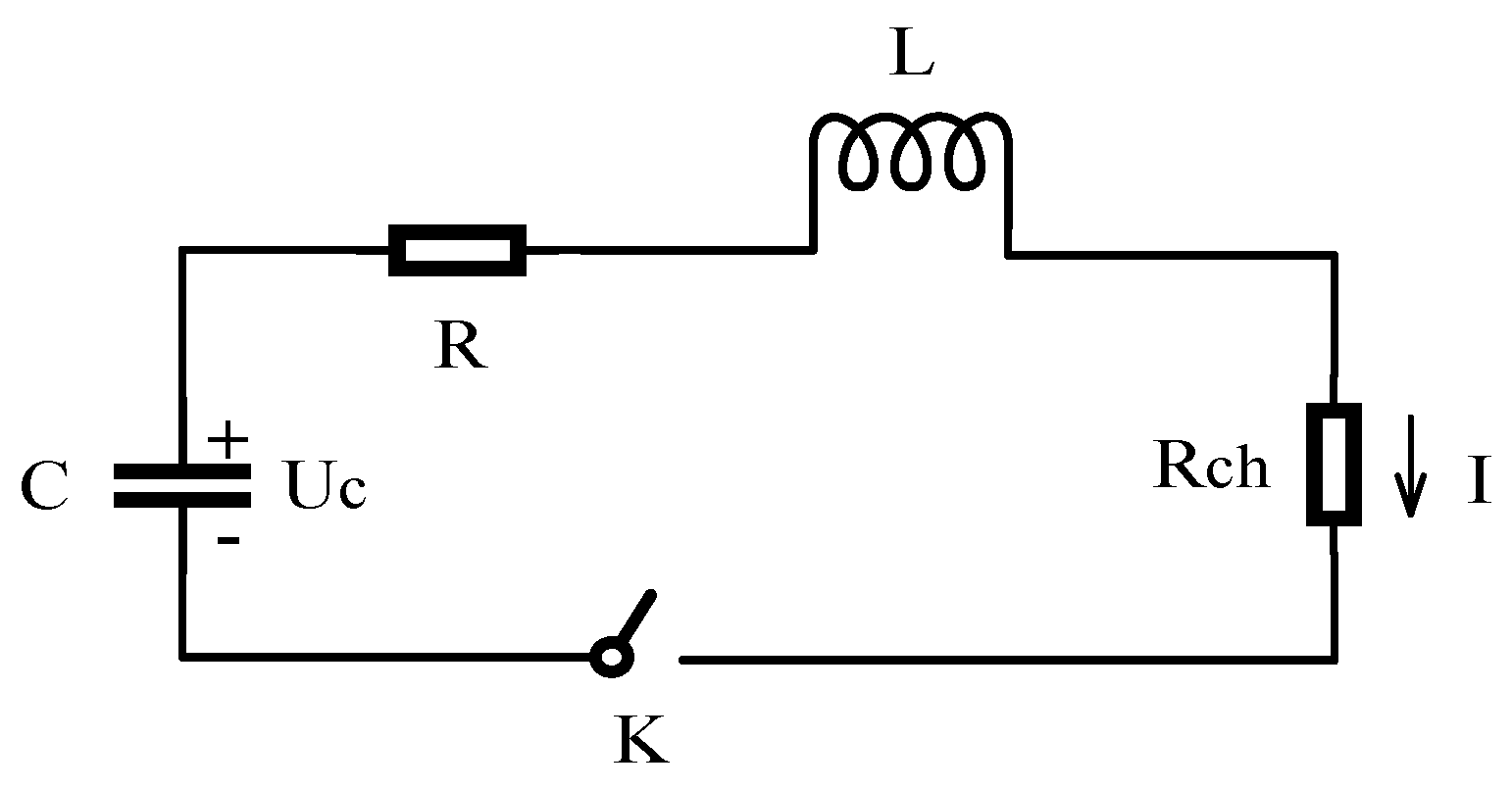

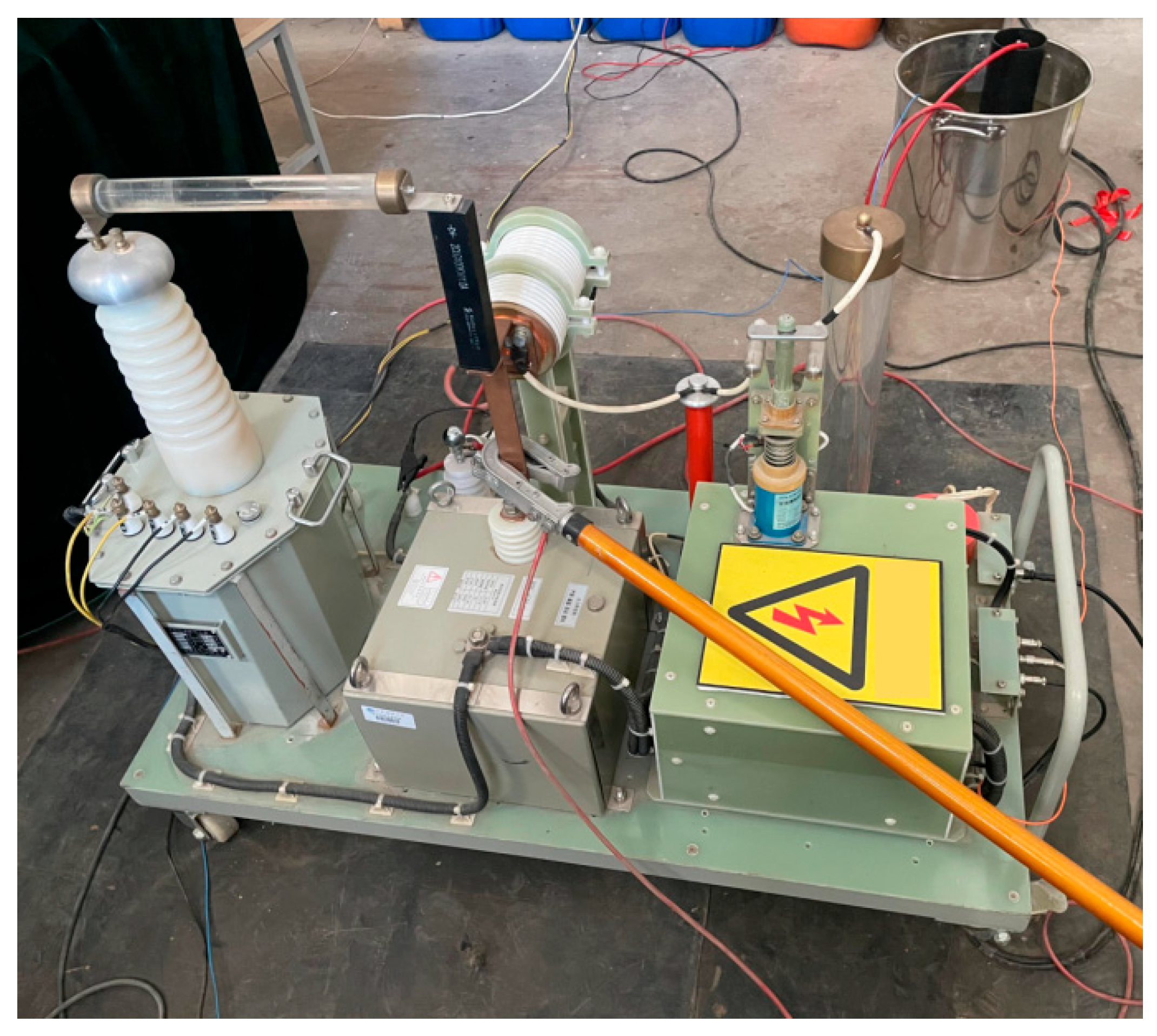
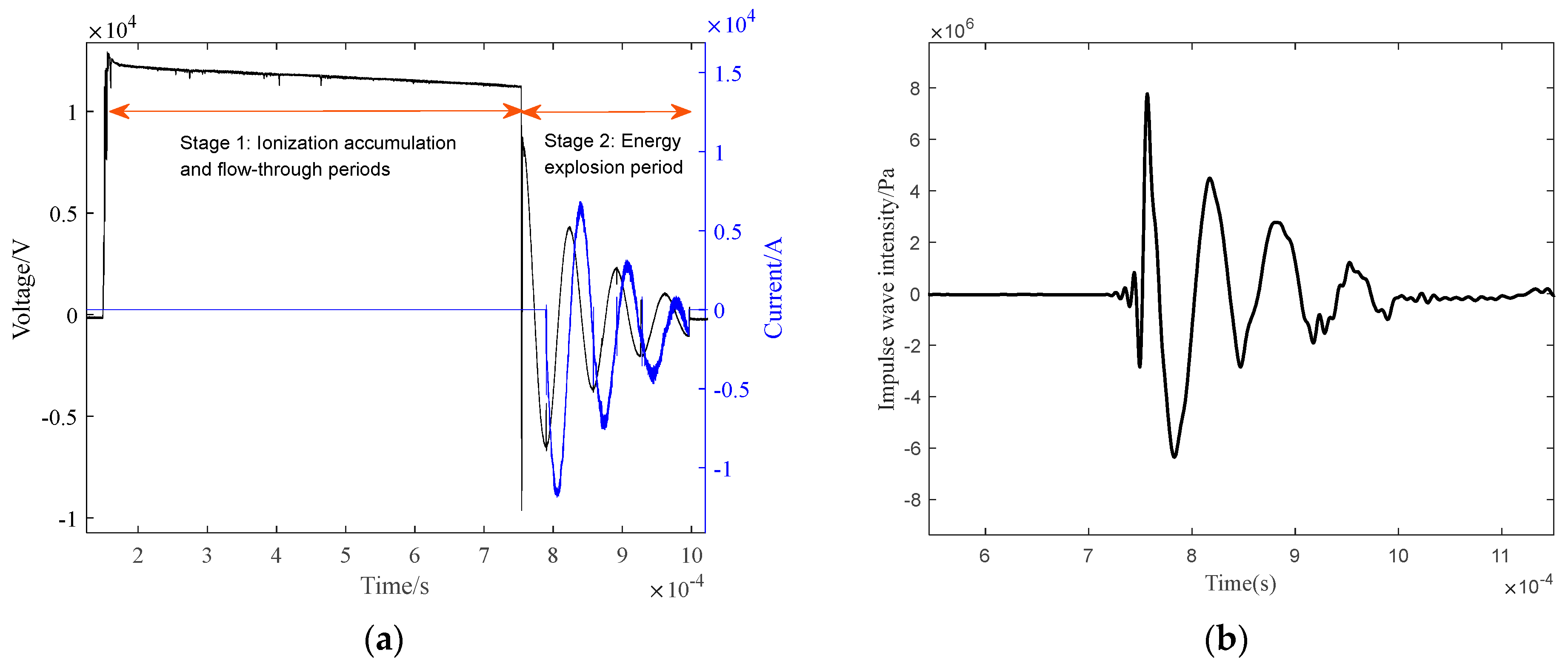
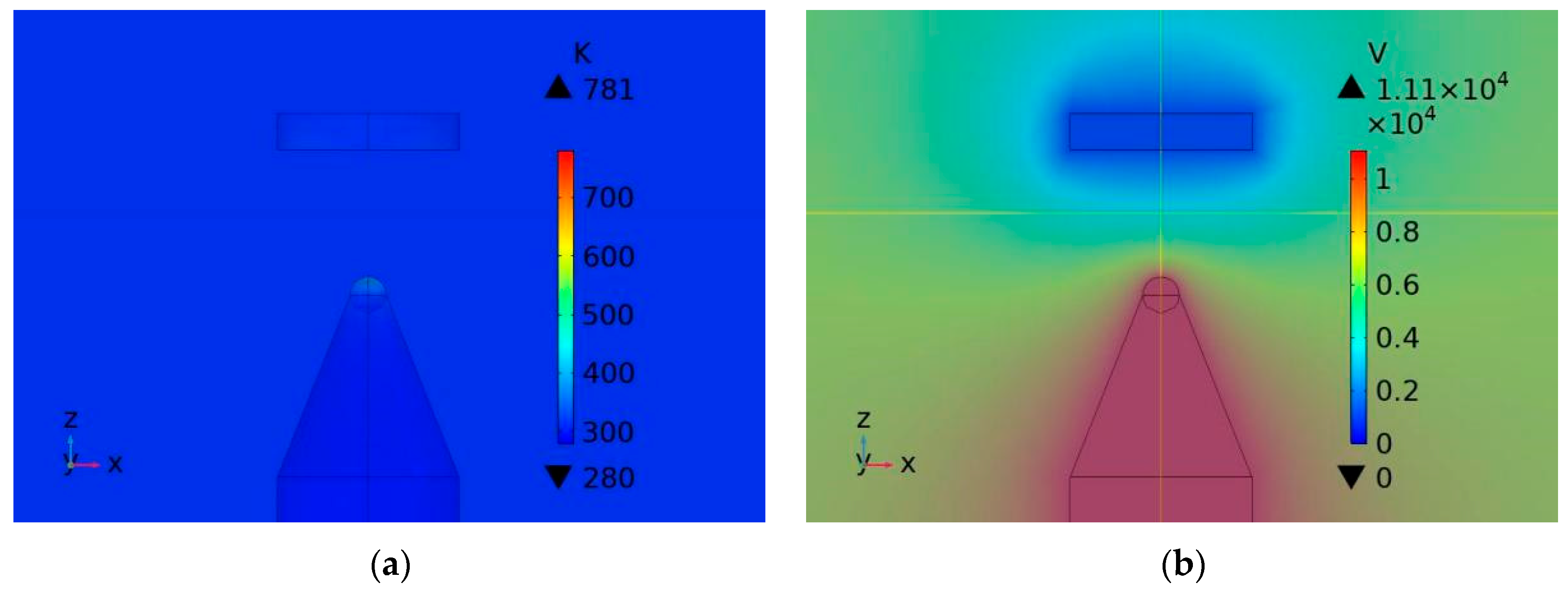
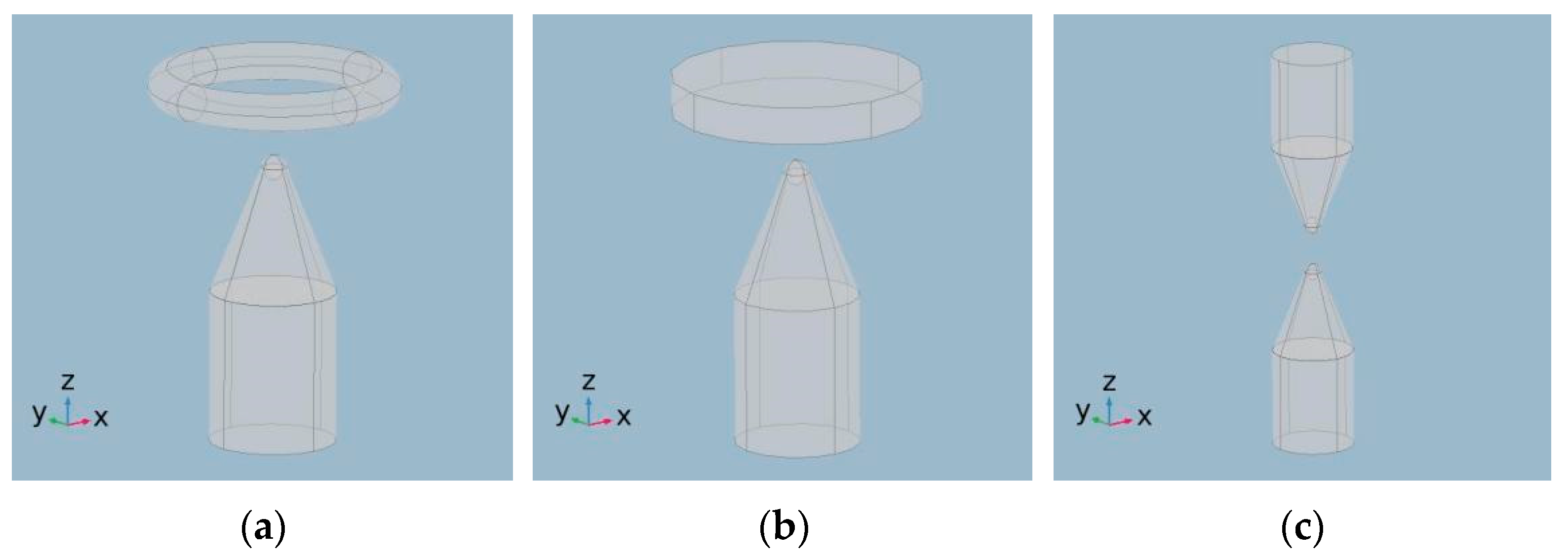

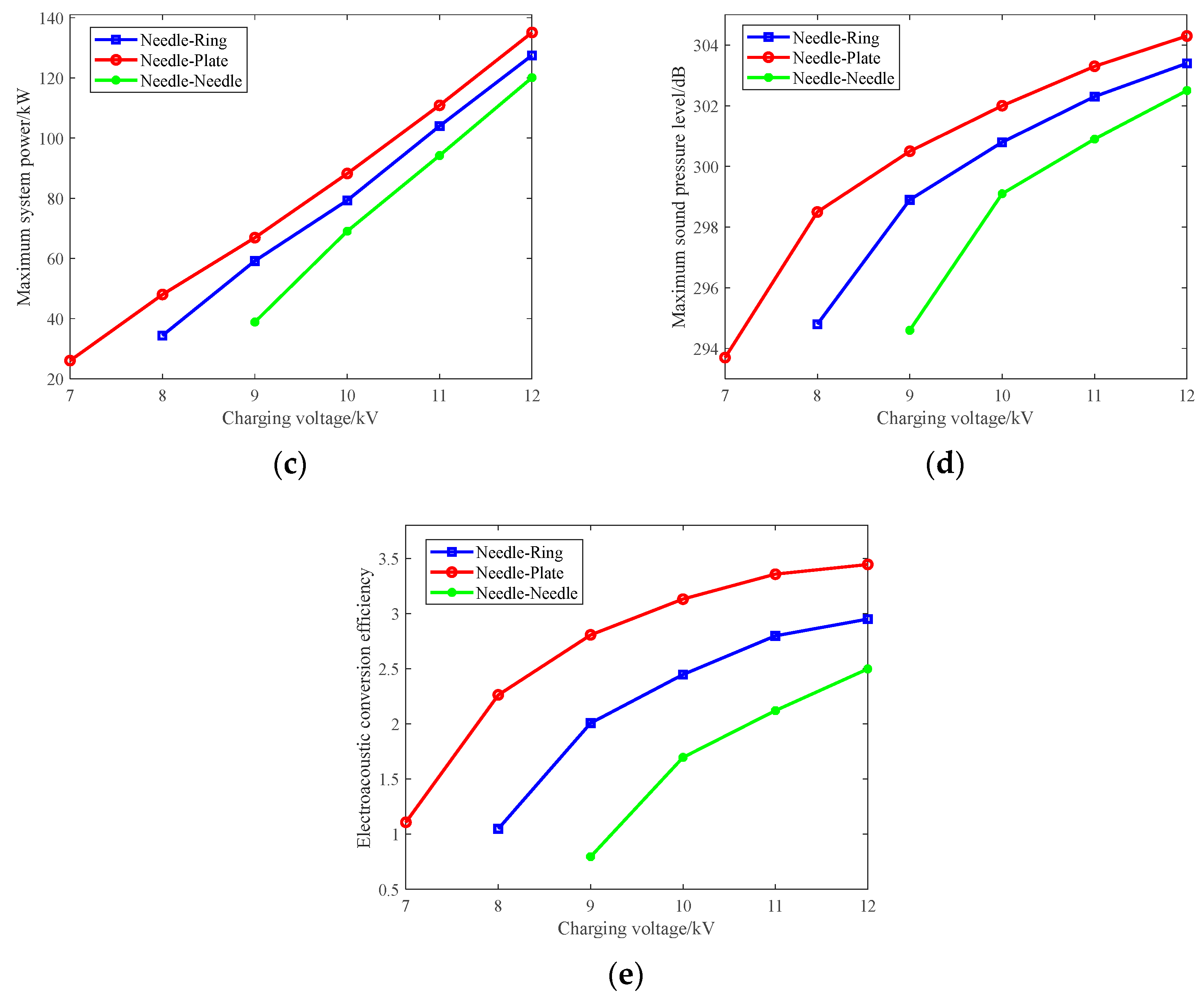
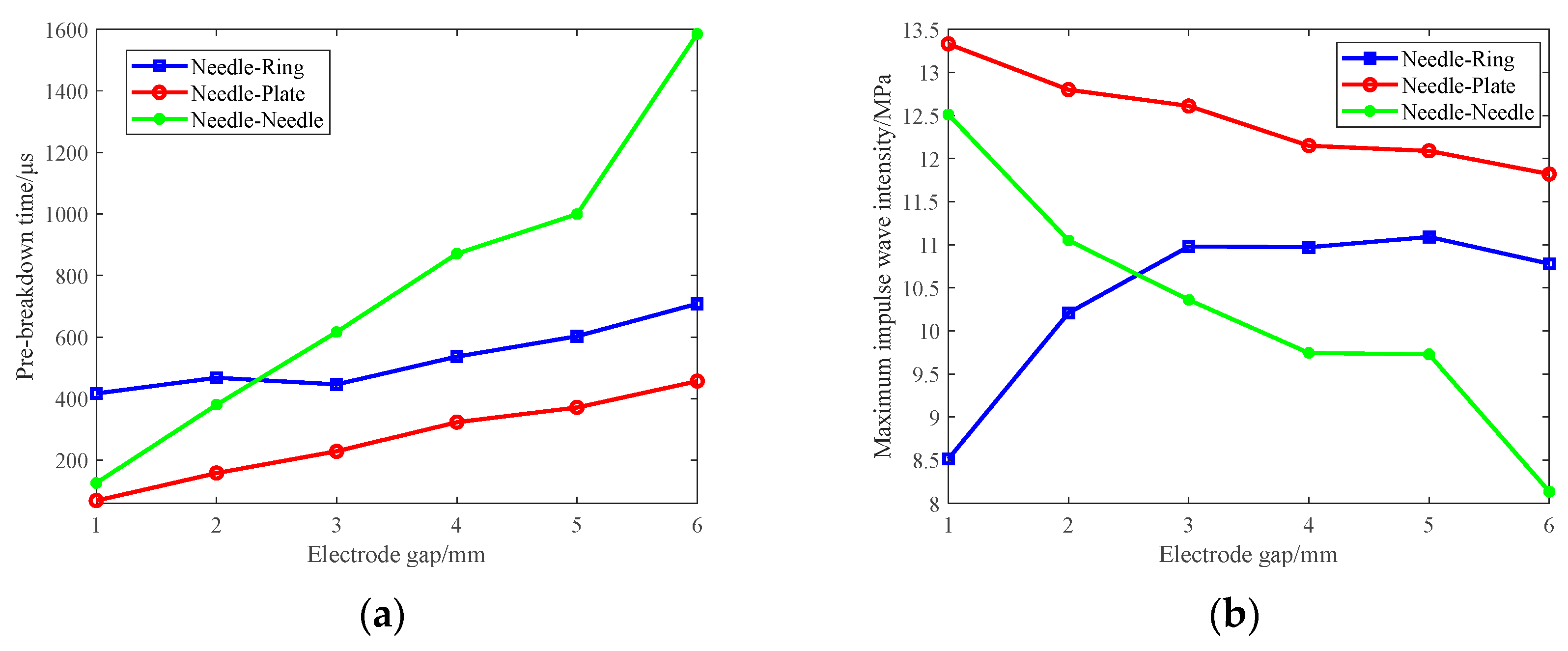
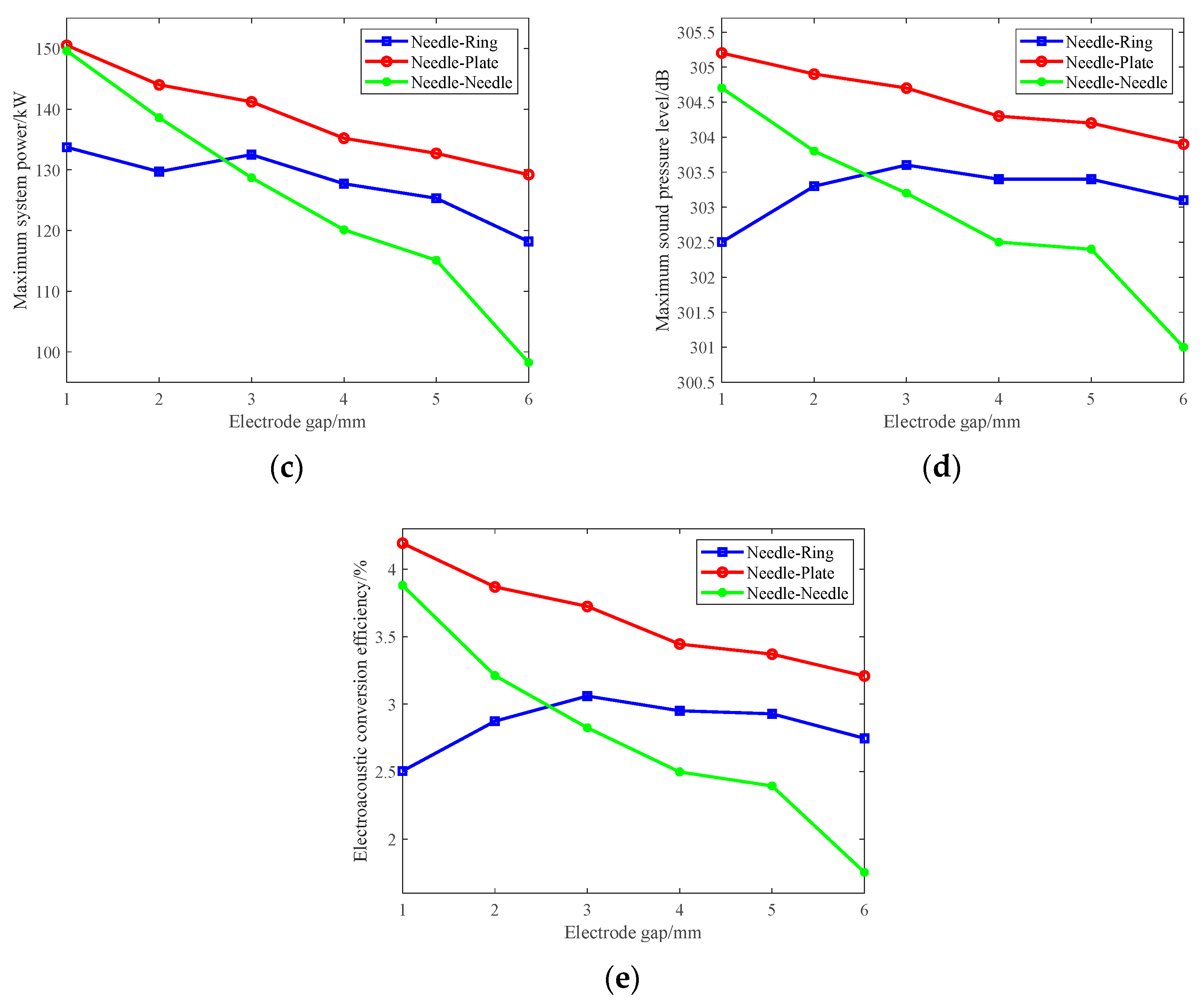
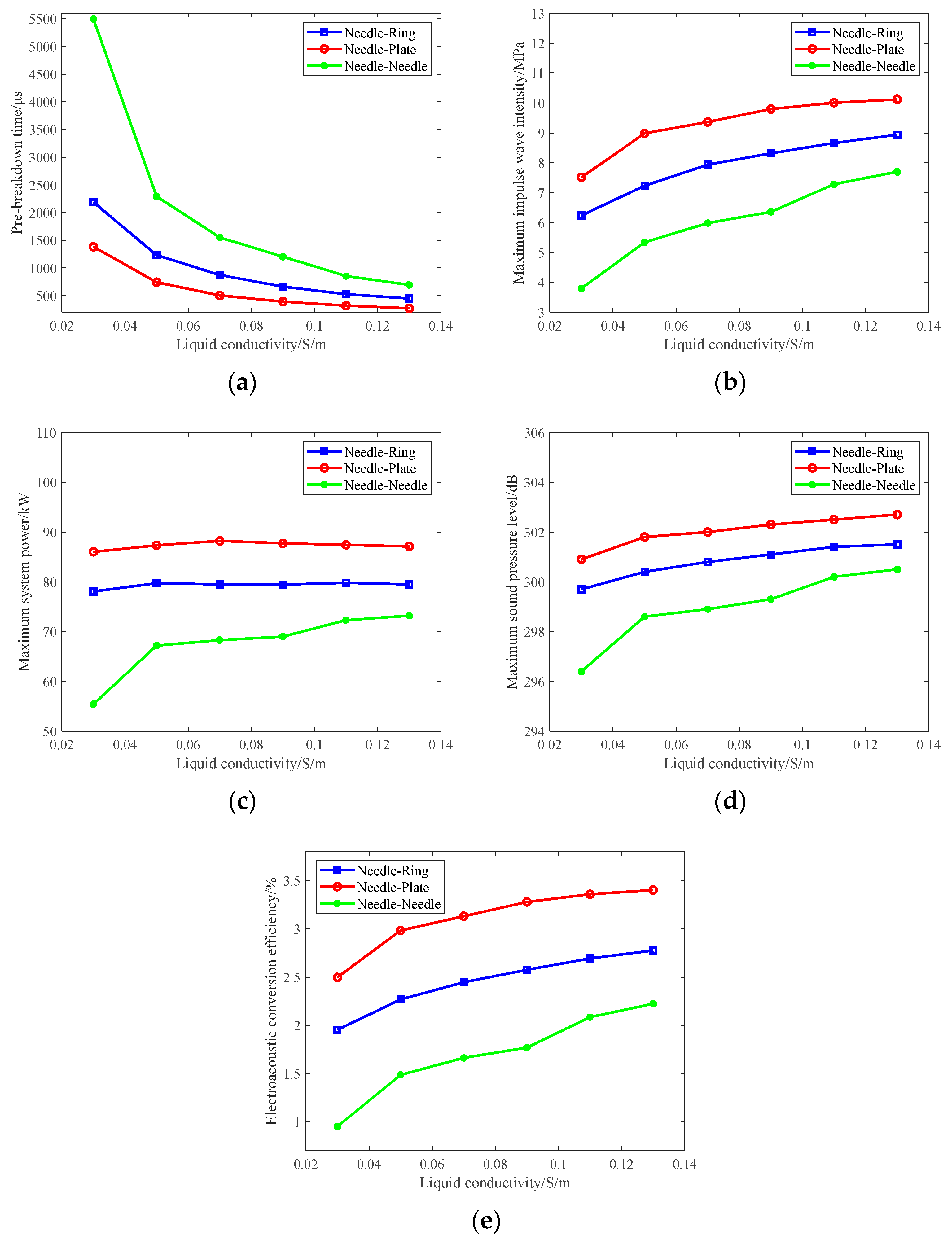
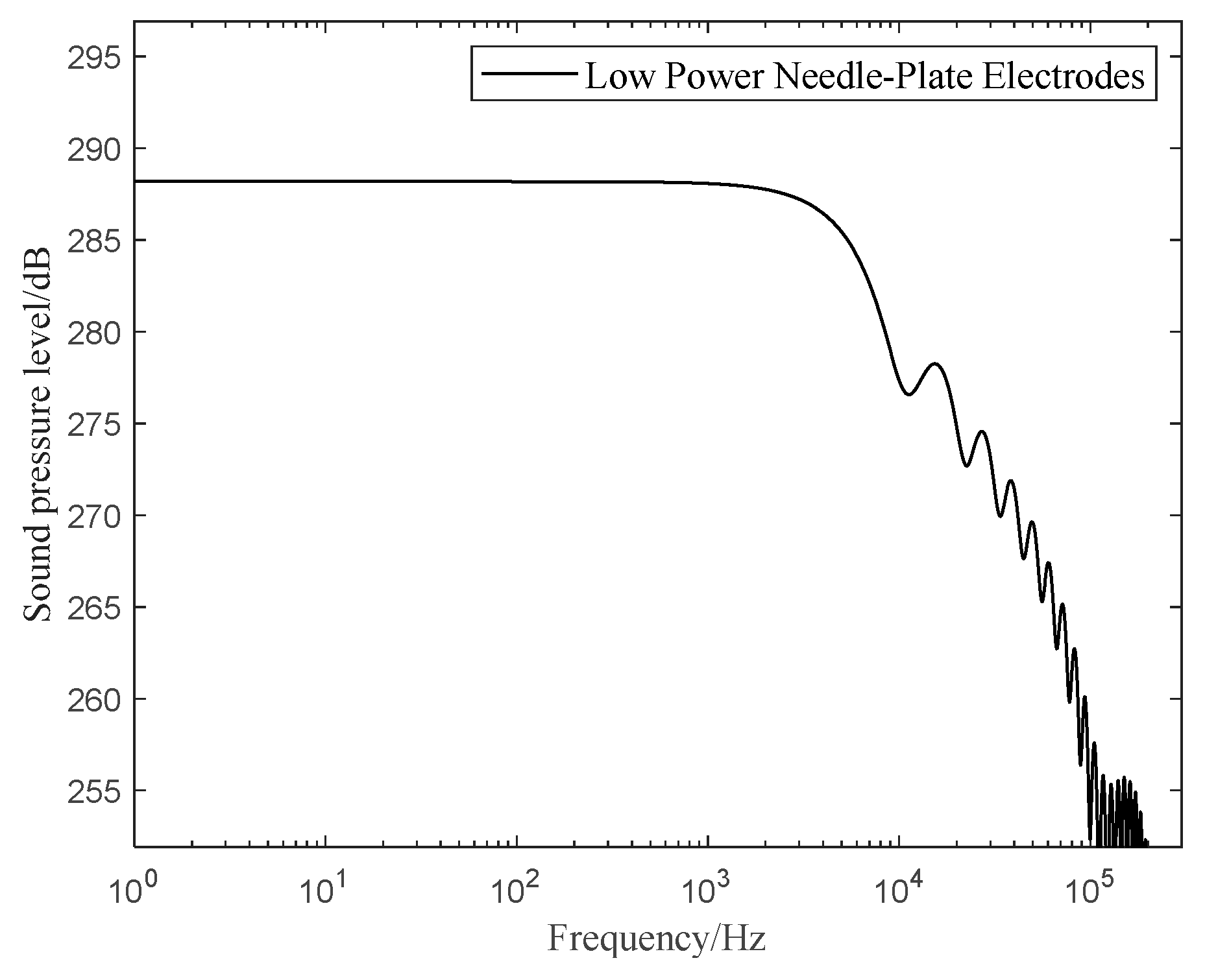
| Size (mm) | Monopole Instrument | Dipole Instrument | Phased-Array Instrument | Impulse Sound Source |
|---|---|---|---|---|
| Bandwidth range | 10–20 kHz | 0.5–5 kHz | Near 14 kHz | 0–100 kHz |
| Azimuthal | Non-directional | 180° uncertainty | Directional | Directionality by concentrating energy |
| Detection distance | Several meters | Several dozen meters | Several dozen meters | Hundred meters |
| Typical Instruments | CLSS, BAR, CrossWave, Shockwave | Sonic scanner, BAT, MAC series | BAR | Theoretical and experimental research stages |
| Structure | Size (mm) | |
|---|---|---|
| Anodic (Needle electrode) | Cone top radius | 1 |
| Cone bottom radius | 5 | |
| Cone height | 10 | |
| Column height | 12 | |
| Cathode (Plate electrode) | Radius | 5 |
| Thickness | 2 | |
| External Circuit Parameters | Liquid Environmental Parameters | ||
|---|---|---|---|
| Charging voltage (kV) | 12.8 | Conductivity (S/m) | 0.07 |
| Energy storage capacitor (µF) | 15 | Initial temperature (K) | 293.15 |
| Equivalent resistance (Ω) | 0.22 | Hydrostatic pressure (Pa) | 101,325 |
| Equivalent inductance (µH) | 8.18 | Relative dielectric constant of water | 81 |
| Parameters | Breakdown Voltage/kV | Pre-Breakdown Time/μs | Peak Current/kA | Peak Impulse Wave Intensity/Mpa |
|---|---|---|---|---|
| Experiment | 11.21 | 595.6 | 11.43 | 7.67 |
| Simulation | 11.1 | 575.44 | 11.86 | 7.89 |
| Relative error | 0.98% | 3.38% | 3.76% | 2.87% |
| Electrode Configuration | Size (mm) | |
|---|---|---|
| Needle electrode | Vertebral apical radius | 1 |
| Radius of the base of the vertebrae | 5 | |
| Vertebral body height | 10 | |
| Needle point-ball radius | 1 | |
| Needle column radius | 5 | |
| Needle column height | 12 | |
| Ring electrode | Large radius | 8.5 |
| Small radius | 1.5 | |
| Plate electrode | Radius | 10 |
| Height | 3 | |
| Charging Voltage of Storage Capacitor/kV | Temperature at the Moment of Breakdown/K | Voltage at the Moment of Breakdown/kV | Gap Mean Field Strength/kV/cm | Electrode Breakdown? |
|---|---|---|---|---|
| 7 | 780 | 6.34 | 63.4 | Yes |
| 6 | 782 | 5.19 | 51.9 | Yes |
| 5 | 778 | 4.01 | 40.01 | Yes |
| 4 | 774 | 2.65 | 26.5 | Yes |
| 3.5 | 775 | 1.81 | 18.1 | Yes |
| 3 | Not breakdown! | |||
| Parameters | Pre-Breakdown Time/µs | Impulse Wave Intensity/MPa | System Power/kW |
|---|---|---|---|
| Value | 831.76 | 1.27 | 6.66 |
Disclaimer/Publisher’s Note: The statements, opinions and data contained in all publications are solely those of the individual author(s) and contributor(s) and not of MDPI and/or the editor(s). MDPI and/or the editor(s) disclaim responsibility for any injury to people or property resulting from any ideas, methods, instructions or products referred to in the content. |
© 2025 by the authors. Licensee MDPI, Basel, Switzerland. This article is an open access article distributed under the terms and conditions of the Creative Commons Attribution (CC BY) license (https://creativecommons.org/licenses/by/4.0/).
Share and Cite
Du, X.; Zhou, J.; Gao, X. Electroacoustic Comparison and Optimization of Low-Power Impulse Sound-Source Needle Series Electrodes. Energies 2025, 18, 3230. https://doi.org/10.3390/en18133230
Du X, Zhou J, Gao X. Electroacoustic Comparison and Optimization of Low-Power Impulse Sound-Source Needle Series Electrodes. Energies. 2025; 18(13):3230. https://doi.org/10.3390/en18133230
Chicago/Turabian StyleDu, Xiao, Jing Zhou, and Xu Gao. 2025. "Electroacoustic Comparison and Optimization of Low-Power Impulse Sound-Source Needle Series Electrodes" Energies 18, no. 13: 3230. https://doi.org/10.3390/en18133230
APA StyleDu, X., Zhou, J., & Gao, X. (2025). Electroacoustic Comparison and Optimization of Low-Power Impulse Sound-Source Needle Series Electrodes. Energies, 18(13), 3230. https://doi.org/10.3390/en18133230





